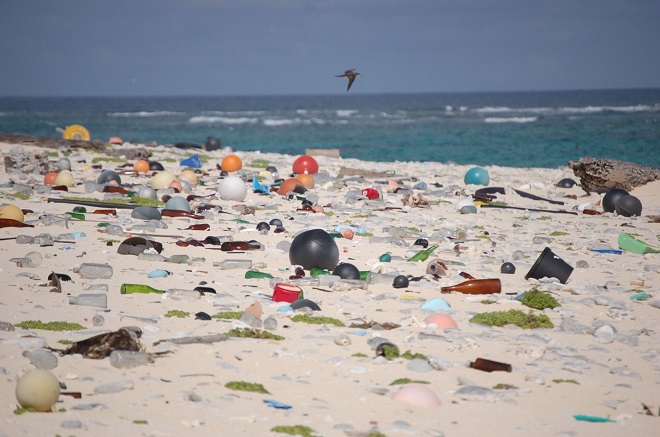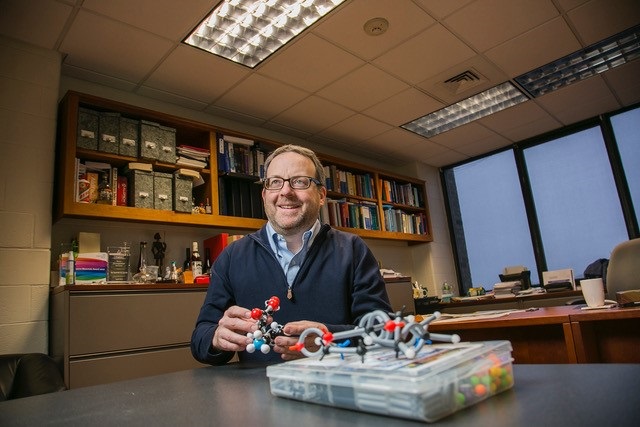 Marine debris litters a beach on Laysan Island in the Hawaiian Islands National Wildlife Refuge, where it washed ashore. Credit: Wikimedia
Marine debris litters a beach on Laysan Island in the Hawaiian Islands National Wildlife Refuge, where it washed ashore. Credit: Wikimedia
The Human population on Earth is expected to reach eight billion by 2024, and could surpass nine billion before 2050. Seemingly the only thing that has outpaced this population growth is the production of plastics—materials composed of polymers that are used to safely store everything from industrial chemicals to the yogurt you had for breakfast. In 1977, we produced 50 million tons of plastics globally. Today, that number has increased to 350 million tons of plastics produced annually, but only around 5% material value is subsequently reused.1 Clearly, plastic waste is a problem that needs to be addressed.
We recently interviewed Geoffrey Coates, PhD, the Tisch University Professor of Chemistry and Chemical Biology at Cornell University, about the problems that plastics present. His research interests lie at the intersection of organic, inorganic, and polymer chemistry. Professor Coates was recognized twice as a Blavatnik Regional Awards Faculty Finalist, in 2007 and 2008.
This interview has been condensed and edited for clarity.

Plastic waste is a global issue that must be addressed. In your opinion, what is the best way to solve this problem? What are some of the obstacles that stand in the way of making this a reality?
Last summer, I was a co-chair on a panel with the Department of Energy, and out of that came a report about not just how to recycle polymers, but also some of the obstacles that must be overcome to solve this problem. In the United States, most towns have curb-side recycling collection, but the problem with that is that you have residual food mixed in, plastic labels on bottles, and many different kinds of plastic mixed together, like polyolefin caps on Coke bottles or polyethylene bottles with polypropylene caps. You can’t just take all these plastics and melt them down and make something new out of it. Since different plastics are made of different polymers, if you do that you will get polymers with really awful properties. For example, you could make a milk jug made from mixed recycled plastic, but the handle would rip off when you tried to pick it up at the store. Unfortunately, in the United States, we are recycling less plastic than we were five years ago. So what we really need to figure out is not how to recycle plastics, but how to upcycle plastics—convert this waste material into products with greater value.
In honor of Earth Day, could you discuss some of your efforts to create greener chemical transformations and sustainable polymers?
In your recycle bin, the majority of the plastic is polyethylene and polypropylene, but as I said earlier, if you melt these down and try to create a new material from the different containers, you would end up with something that is less desirable because the two polymers never really mix together to form a homogeneous product.
One of our most successful projects involved the creation of a block copolymer that contains both polyethylene and polypropylene in a single molecule. In order to create this molecule, we discovered a catalyst that allowed us to change the nature of the polymer midstream, and so now we can engineer our polymer to contain different ratios of these building blocks.
The advantage to using a single polymer that contains both polyethylene and polypropylene is that you can throw it in with a mixture of polyethylene and polypropylene containers, and since it has blocks of each, you can melt it down and it “stitches” these materials together. So instead of the resulting material being really crumbly, this basically glues microscopic domains of the polymers together, and in the end, you actually get something that is really impact-resistant like polyethylene and simultaneously rigid like polypropylene. This is one of our contributions to the idea of upcycling, and it has very recently spawned a startup called Intermix Performance Materials, and we’re really excited about the prospects of what this company can produce.

How important is it to encourage chemists in both academia and industry to pursue sustainable chemistry?
It is always important to think about how our work can be sustainable and contribute to a sustainable plastics economy, but in order for that to happen, we need to understand the basics of how to make things. If we’re going to design a plastic food container that might unfortunately one day find its way into the ocean, we need to understand organic photochemistry and thermodynamics and kinetics and biochemistry to see how the breakdown of this material might affect seawater and ocean life for the next 50 to 100 years. So in order to solve these types of problems, we really need to understand the basics of multiple disciplines.
I like to think of the work we do as “use-inspired basic research” in that we are discovering new ways to make materials that could have useful applications, but we are using very basic, fundamental scientific principles throughout entire the process. We think we can make the world a better place by creating new and exciting polymers.
What is up next for the Coates lab? Are there projects that you are particularly excited to see gain traction?
We've started getting into sustainable energy materials that could potentially help with energy storage and conversion. We’re trying to figure out whether you can replace some of the traditional materials that go into batteries or fuel cells with polymers. One of the problems with lithium ion batteries is that they often contain flammable solvents, so if a battery ruptures or experiences internal thermal runaway—an event caused by a defect that leads to overheating—this solvent can be a real negative. Polymers can replace these solvents, but they generally have poor conductivity. We’ve developed a new family of polymers that have high conductivity at room temperature, and that also suppress the formation of harmful lithium dendrites—finger-like structures that can grow inside batteries, eventually causing the battery to short circuit. Dendrite formation has become a real problem, especially in rechargeable batteries, so suppression of dendrites can be a real advantage. Overall, we’re very excited about the possibilities that novel polymer materials can bring to this space.
1 https://www.ellenmacarthurfoundation.org/assets/downloads/publications/NPEC-Hybrid_English_22-11-17_Digital.pdf